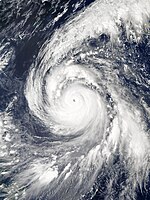User:Terryfirut/Typhoon Kong-rey (Queenie)
Typhoon Kong-rey (Queenie)
[edit]| Violent typhoon (JMA) | |
| Category 5 super typhoon (SSHWS) | |
| Duration | September 28 – October 6 |
|---|---|
| Peak intensity | 215 km/h (130 mph) (10-min); 900 hPa (mbar) |
In late September 2018, a tropical disturbance formed in the waters near Pohnpei Island in the Federated States of Micronesia. The Joint Typhoon Warning Center also gave the storm, Invest 94W, a low chance of development.[1] Over the next couple of days, the system moved westward and organized into a tropical depression on September 27, and the JMA initiated advisories on the storm, while the JTWC issued a TCFA. On September 28, the JTWC designated the system as 30W,[2] while the JMA issued a gale warning for the system.[3] As Tropical Depression 30W continued strengthening, the system became a tropical storm and was named Kong-rey by the JMA. On September 29, the system moved further west, found itself in favorable conditions for strengthening, and became a tropical storm. Later that day, Kong-rey strengthened into a severe tropical storm, and on September 30, the storm attained typhoon status at 03:00 UTC. Kong-rey continued strengthening, and at 18:00 UTC on October 1, Kong-rey became a Category 4-equivalent super typhoon. Early on October 2, Kong-rey strengthened into a Category 5 super typhoon. Affected by vertical wind shear, low ocean heat content and decreasing sea surface temperatures, the storm gradually weakened to a Category 3 typhoon on October 3 while undergoing an eyewall replacement cycle.[4] Increased vertical wind shear and lower sea surface temperatures hampered Kong-rey's strength, and Kong-rey was downgraded to a tropical storm on October 4. Early on October 6, Kong-rey made landfall in Tongyeong, South Gyeongsang Province in South Korea as a high-end tropical storm,[5] and later on the same day, Kong-rey transitioned into an extratropical cyclone, while impacting southern Hokkaido, such as areas near Hakodate.
As of October 2018, 3 people have been killed by the storm, including 2 people from South Korea.[6] Damage nationwide totaled at ₩54.9 billion (US$48.5 million).[7] Although Kong-Rey did not make a direct landfall on Kyushu and Shikoku, its outer rainbands affected the two islands. At an area in Shikoku, rain accumlated to 300 mm. In Nagasaki, more than 12,000 families lost power;[8] in Fukuoka Prefecture, a person died because of the rain.[9] Agricultural damage in Okinawa and Miyazaki Prefecture were about JP¥13.99 billion (US$123 million).[10][11]
Unrelated to Kong-rey, Hurricane Walaka was a Category 5 hurricane at the same time Kong-rey intensified to Category 5 super typhoon intensity, marking the first time since 2005 when two tropical cyclones of Category 5 strength existed simultaneously in the Northern Hemisphere.[12]
- ^ "Prognostic Reasoning for Tropical Disturbance 94W". 2018-09-25. Archived from the original on 2018-09-25.
- ^ "熱帶性低氣壓WP302018 #1". 2018-09-28. Archived from the original on 2018-09-28.
- ^ "日本氣象廳2018年西北太平洋第35號熱帶低氣壓烈風警告 #1". 2018-09-29. Archived from the original on 2018-09-28.
- ^ "康芮強度今晚起減弱! 專家:近台時是中颱等級" (in Chinese). Taiwan. 2018-10-02. Retrieved 2018-10-03.
- ^ 郭展毓 (2018-10-06). "「康芮」登陸南韓慶南 釜山已現強風雨" (in Chinese). Hong Kong: TVBS新聞網. Retrieved 2018-10-06.
- ^ "Tropical Storm Kong-rey Leaves 2 Dead, 1 Missing In South Korea | The Weather Channel". The Weather Channel. Retrieved 2018-10-09.
- ^ "정부, 태풍 콩레이 피해복구비 2360억 지원" (in Korean). Newsis. October 30, 2018. Retrieved October 31, 2018.
- ^ "颱風「康妮」周六吹向日本西南部及韓國 長崎縣約1.2萬戶停電" (in Chinese). 王海如. 2018-10-07. Retrieved 2018-10-08.
- ^ "颱風「康妮」吹襲韓國 韓2人死亡1人失蹤 日1人死亡" (in Chinese). 王燕婷. 2018-10-07. Retrieved 2018-10-08.
- ^ "農作物の台風被害拡大 沖縄、24号と25号で20億円" (in Japanese). Ryūkyū Shimpō. October 10, 2018. Retrieved October 31, 2018.
- ^ "農林水産被害120億円 台風24、25号で県確定" (in Japanese). Miyazaki Nichinichi Shinbun. November 16, 2018. Retrieved November 17, 2018.
- ^ Matthew Cappucci (October 2, 2018). "Two monster tropical cyclones are raging in the Pacific Ocean". The Washington Post. Retrieved October 14, 2018.


